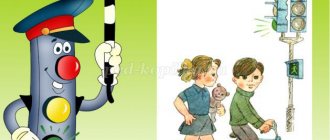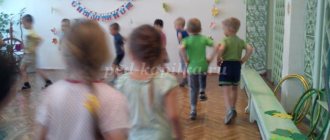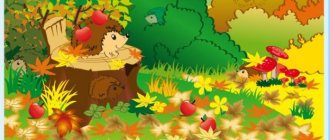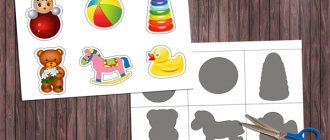Methodology for guiding design and construction games in different age groups
Children of primary preschool age typically depict single objects or small structures. The themes of these buildings are closely related to the role-playing games of children: they build a house for a doll (bear), a crib, a table, a fence, a garage. The construction of the buildings is very elementary. Children arrange the building as if in a horizontal plan - they “draw” rather than build. A bear house is a space fenced off with several cubes. In the best case, a plate is placed on top as a roof.
Younger children are also characterized by a certain process: having erected a building, they destroy it and begin to build again. Often construction is ahead of the plan, having started to build, the child then “recognizes” some object in the construction.
For middle-aged and older children, there is a gradual expansion of the themes of buildings. These are various buildings, ships, cars, bridges. The design is distinguished by the desire to convey the originality of specific structures: children are building not just a bridge, but the Kirov Bridge across the Neva, not just a metro, but the Ploshchad Vosstaniya metro station, building the Moscow Kremlin, the Ostankino TV tower, etc. The design itself is gradually becoming more complex, the buildings seem to grow upward, children decorate them in a variety of ways (towers, columns, etc.), use various ceilings.
Most Soviet researchers note that without special training in construction skills and abilities, without targeted guidance from adults, children’s buildings remain very elementary in design and poor in subject matter.
There are two ways to guide construction games:
The first way is to teach children constructive activities in the classroom.
The second way is to teach methods of design and development of constructive skills and abilities in the process of guiding children’s independent games.
During the learning process, children master the necessary technical skills, thanks to which the themes of their buildings expand. At the same time, as in independent play, children move from constructing individual objects to constructing structures. Learning to design in the classroom develops their ability to plan their activities and select material in accordance with the plan. Children's knowledge about the design features of materials is enriched. For example, different materials require different methods of fastening: some - gluing, others - stitching, others - screwing, overlaying, etc. During the learning process, there is an active and systematic improvement in the mental activity of children, and this contributes to the development of independent construction games, in during which children apply the knowledge and skills acquired in class. However, teaching children how to design in the classroom does not exclude the possibility and necessity of guiding children’s design during play.
Organized, targeted observations and examination of objects, buildings, and structures are essential for the development of design. During the observation, the vital purpose of the observed structure, features of its design, proportions of parts, etc. are clarified; children's attention is directed to the beauty of the building, its expediency; it is established how this is achieved. The observation is accompanied by a conversation about which parts of the building material can be used to make this or that part of the structure. Observation of objects and structures is supplemented by viewing paintings, photographs, and schematic drawings. In the process of teaching constructive skills, various methodological techniques are used: demonstration of a sample; demonstration of construction methods with explanation of design techniques; formulation of a problem problem (how to rebuild a garage so that 2-3 cars fit in it); message about the topic of the building, indicating the conditions that it must meet (build a room for a family with a certain number of people).
The teacher’s guidance of the game itself is aimed at developing its content and at forming correct friendly relationships between the players. The techniques for directing these games for children are the same as for role-playing games. The younger the children, the more often the teacher takes a direct part in the game: he encourages, provides assistance, sometimes suggests the topic of construction, shows how to do it, builds with the children, etc. He builds himself in the presence of children of primary preschool age, involves the kids in playing buildings (different animals live in cages at the zoo, children come there with their parents).
Uses the technique of co-creation:
- invites children (in different age groups) to complete, rebuild, transform the building that he built (add a porch, balcony;
- build a high or low fence around the house;
— change the height of the slide;
- make a springboard for skiers from the slide;
— lengthen the bridge;
- widen the path).
The teacher shows the model to children 2-3 years old, and then the children build it together. As experience accumulates, a partial model is offered, i.e., the child is shown only those techniques that are unfamiliar to him. By participating in the games of young children, the teacher helps them organize for joint construction and play around it (“they made a bus and went to the country”), determine who will build what, explain to individual children the general design of the building, etc.
Middle-aged children can be offered a demonstration of an unfinished example of a building, which everyone can complete in their own way (the teacher builds the frame of a carriage, the children turn it into a bus, tram, passenger car). You can propose changing the building model (add or subtract a floor).
The teacher Together with the children, he discusses what and how should be changed in the building, how to supplement it. In cases where children cannot overcome the difficulty that has arisen, the teacher shows the necessary technical techniques (for example, how to strengthen the ceiling, how to movably connect two parts, etc.), but always strives to encourage children to take initiative
It is necessary to cultivate in children the ability to play together, without suppressing each other’s initiative.
In construction games, middle-aged and older children should be taught to independently agree on the topic of construction, distribute responsibilities, select materials, etc. It is useful, after completing the overall construction, to review with the children its compliance with the plan, and discuss the participation of each child. For preschoolers who have experience in constructive activities, it is advisable to offer not one sample, but 2-3 samples to choose from. For older children, a drawing, drawing, or construction diagram are used as a model. They are also taught to draw up a diagram of the proposed building, independently outlining its design features. The methodology for teaching children constructive skills is specified depending on the type of construction.



